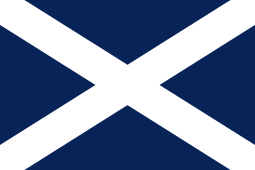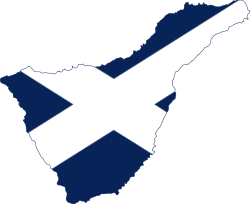Flag of Tenerife
 | |
| Use | Civil and state flag |
|---|---|
| Proportion | 5:3/3:2 |
| Adopted | 9 May 1989 |
| Design | White saltire on a navy blue field |
The flag of Tenerife is a white saltire (or Cross of Burgundy or St Andrew's Cross)[1] over a blue field. The arms of the cross are approximately one fifth the width of the flag and the field is navy blue (azul marino).
Significance
There is no official meaning to justify the colours of the flag, but blue and white colours have been identified on the island of Tenerife for centuries. Traditionally, navy blue has been identified with the sea and the white to the snow-covered peaks of Mount Teide in winter.
Juba II and Ancient Romans referred to Tenerife as Nivaria, derived from the Latin words nix, nivis or nives, meaning snow, in clear reference to the snow-covered peak of the Teide volcano.
The name of Tenerife is derived from the language of the Benehaorits - the natives of nearby La Palma. Tene means mountain and ife means white. After colonisation by Spain, the letter r was added, uniting both words.
History

The flag was first adopted as a maritime registry flag of the maritime province of the Canary Islands. It was initially adopted in 1845 by Royal Order and was adopted as the flag of Tenerife by an Order issued on 9 May 1989, with the order appearing in the Boletín Oficial de Canarias on 22 May 1989.[2]
The flag is similar to the Flag of Scotland in design. The difference is that the Scottish Saltire's field colour is usually approximated around Pantone 300 (azure or sky blue) instead of the Tenerife's darker navy blue field.
There are two popular traditions on the island of Tenerife trying to explain the resemblance of the Flag of Tenerife with the Flag of Scotland.
One is that the flag was adopted as a mark of respect to the bravery of the Scottish sailors in the Battle of Santa Cruz.
An alternative theory is the most influential masters of the island of Tenerife chose a design similar to the Scottish flag belonged to the Masonic Grand Lodge of Scotland and proposed a similar flag for the maritime province of the Canary Islands, which later became the flag of Tenerife.[3]
Flags with the same origin
- The flag of the province of Santa Cruz de Tenerife is the same, with the provincial shield in the centre.
- The flag of Club Deportivo Tenerife is also the same, with the shield of the entity at the centre.
- The Flag of Canary Islands, has in two colours (white and blue) representation of Tenerife and its province.
Similar flags
-

Flag of the former maritime province of the Canary Islands, which is based on the current flag of Tenerife.
See also
References
- ↑ Bandera de Tenerife. Boletín Oficial de Canarias
- ↑ Bandera de Tenerife. Boletín Oficial de Canarias
- ↑ La bandera de la Isla cumple 170 años
External links
- Flags of the Canary Islands. Retrieved on 2006-10-16.
- Flag of Tenerife from Tenerife Island Council. Retrieved on 2006-10-16.

